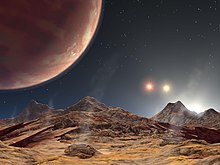Gwiazda wielokrotna
| Ten artykuł od 2015-07 wymaga zweryfikowania podanych informacji. |
Gwiazda wielokrotna – układ gwiazd, które znajdują się w niedalekiej odległości w przestrzeni (układy fizycznie wielokrotne) lub na nieboskłonie (układy optycznie wielokrotne).
Większość gwiazd na niebie należy do grupy gwiazd wielokrotnych (ponad 50%).
- Najczęściej w układzie znajdują się dwie gwiazdy – gwiazda podwójna (6/10 gwiazd z powyższej grupy).
- Układy trzech gwiazd to około 3/10.
- pozostałe układy czterech lub więcej gwiazd to 1/10 tej grupy.
Układy optycznie wielokrotne
Układy optycznie wielokrotne to grupa gwiazd, które, oglądane na niebie znajdują tuż obok siebie. Gwiazdy te nie muszą być fizycznie związane i może dzielić je znaczna odległość w przestrzeni, a jedynie widziane z Ziemi wydają się być blisko.
Przykładem takiego układu gwiazd są Alkor i Mizar w gwiazdozbiorze Wielkiej Niedźwiedzicy.
Układy fizycznie wielokrotne
W tej grupie znajdują się:
- Układy zaćmieniowe
Gwiazda okresowo zmienia blask, w trakcie gdy jeden ze składników przechodzi przed innym (względem Ziemi) i zasłania go. Przykładem jest Algol w Perseuszu.
- Układy astronometrycznie podwójne
To układy, które można wykryć tylko przez dokładny pomiar ruchu. Trasa ruchu gwiazdy okrążanej przez niewidzialnego towarzysza przypomina wykres sinusoidalny.
- Układ potrójny
Układ potrójny to układ w skład którego wchodzą trzy gwiazdy związane ze sobą grawitacyjnie. W zależności od tego, jak daleko od siebie znajdują się poszczególne składniki, mogą one oddziaływać na siebie w sposób nieraz dramatyczny – siły pływowe zdolne są "wysysać" materię gwiazdy o mniejszej masie w kierunku gwiazdy o większej masie. Orbity takich układów są często bardzo skomplikowane (zob. HD 188753 A b – pierwsza planeta odkryta w układzie potrójnym).
- Układy spektroskopowo wielokrotne
W tych układach gwiazdy krążą tak blisko siebie i są tak odległe od Ziemi, że trudno wykryć poszczególne składniki, nawet przez potężne teleskopy. Jedynym sposobem, aby ocenić, czy gwiazda może być wielokrotna, jest analiza spektroskopowa. Obecność towarzysza (-y) objawia się regularną zmianą linii Fraunhofera w widmie gwiazdy. Przykładem takiej gwiazdy jest Capella w Woźnicy.
Zobacz też
Media użyte na tej stronie
Autor: Merikanto, Licencja: CC BY-SA 4.0
Animation of Algol-type eclipsing binary star.
Artist's conception of the three suns and the newly discovered Jupiter-sized planet from the perspective of a hypothetical moon orbiting the planet. The large yellow sun is already halfway over the horizon. The orange and red suns are still visible in the sky. This artist's animation shows the view from a hypothetical moon in orbit around the first known planet to reside in a tight-knit triple-star system. HD 188753 Ab is a gas giant planet, about 1.14 times the mass of Jupiter, with an orbital period of 3.3 days discovered using the Keck I telescope atop Mauna Kea in Hawaii, and zips around a single star that is orbited by a nearby pair of pirouetting stars. Because the stars in this triple system are bunched together, sunsets on the planet -- or on any moons that might exist around the planet -- would be spectacular. This rambunctious stellar family is called HD 188753 and is located 149 light-years away in the constellation Cygnus.
In this movie, sunset is seen through the tenuous atmosphere of a hot, baked hypothetical moon. As the suns dip below the horizon, the gas giant comes into view. The moon's landscape remains illuminated by sunlight reflected off the planet. Both the planet and moon would be so hot that even in shadow their surfaces would glow.
The suns' colors and sizes reflect their masses, temperatures and distances to the planet. For example, the first star shown setting over the horizon is the closest, most massive and hottest of the trio, so it is depicted as large and white. The second star is farther away, less massive and cooler than the first, appearing smaller and yellow. The final star is at the same distance as the second, but it is still less massive and cooler, appearing even smaller and orange-red in color. Our Sun is a bit cooler than the hottest star of the system.
The graph in figure 1 shows the "wobble" of a star being tugged on by the planet called HD 188753 Ab. The planet was discovered via the radial velocity technique, in which a planet's presence is inferred by the motion, or wobble, it causes in its parent star. Stellar motion is plotted here as changes in velocity (y-axis) versus time (x-axis).
Unlike most planetary wobbles, this one comes from a star that is circled by a nearby pair of stars. In other words, the planet orbits a single star that is part of a close-knit triple-star system. Because the starlight from this cramped bunch blends together, the task of sifting through the light to find the planet's signature was more difficult. This challenge was overcome with the help of detailed models of the triple-star system's light. Data from those models resulted in precise velocity measurements of the star circled by HD 188753 Ab.
Note: The size of the Full-Res TIFF for the still image is 3200 samples x 2400 lines.


